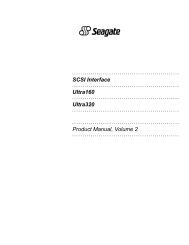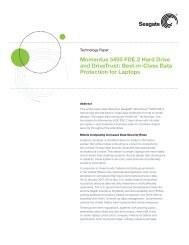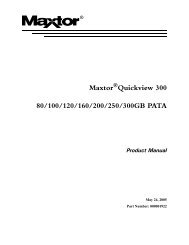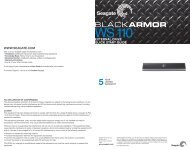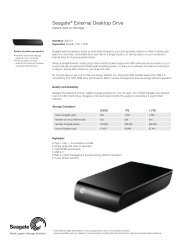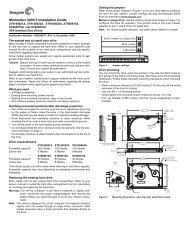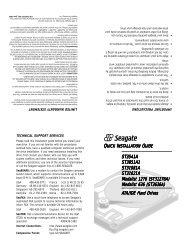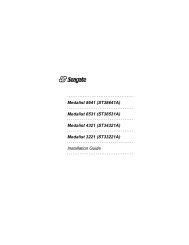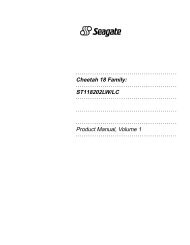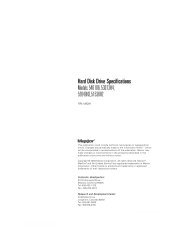Barracuda 18LP Family: ST39175LW/LC ST318275LW ... - Seagate
Barracuda 18LP Family: ST39175LW/LC ST318275LW ... - Seagate
Barracuda 18LP Family: ST39175LW/LC ST318275LW ... - Seagate
Create successful ePaper yourself
Turn your PDF publications into a flip-book with our unique Google optimized e-Paper software.
16 <strong>Barracuda</strong> <strong>18LP</strong> Product Manual, Rev. E<br />
The drive can be interrogated by the host to determine the time remaining before the next scheduled measurement<br />
and data logging process will occur. This is accomplished by a log sense command to log page 0x3E.<br />
The purpose is to allow the customer to control when S.M.A.R.T. interruptions occur. As described above, forcing<br />
S.M.A.R.T by the RTZ command will reset the timer.<br />
Performance impact<br />
S.M.A.R.T. attribute data will be saved to the disc for the purpose of recreating the events that caused a predictive<br />
failure. The drive will measure and save parameters once every two hours subject to an idle period on the<br />
SCSI bus. The process of measuring off-line attribute data and saving data to the disc is uninterruptable and<br />
the maximum delay is summarized below:<br />
Maximum processing delay<br />
On-line only delay Fully enabled delay<br />
DEXCPT = 0, PERF = 1 DEXCPT = 0, PERF = 0<br />
S.M.A.R.T. delay times 30 milliseconds 200 milliseconds<br />
Reporting control<br />
Reporting is controlled in the “Informational Exceptions Control Page” (1Ch). Subject to the reporting method,<br />
the firmware will issue to the “host” an 01-5D00 sense code. The error code is preserved through bus resets<br />
and power cycles.<br />
Determining rate<br />
S.M.A.R.T. monitors the rate at which errors occur and signals a predictive failure if the rate of degraded error<br />
rate increases to an unacceptable level. To determine rate, error events are logged and compared to the number<br />
of total operations for a given attribute. The interval defines the number of operations over which to measure<br />
the rate. The counter that keeps track of the current number of operations is referred to as the Interval<br />
Counter.<br />
S.M.A.R.T. measures error rate, hence for each attribute the occurrence of an “error” is recorded. A counter<br />
keeps track of the number of errors for the current interval. This counter is referred to as the Failure Counter.<br />
Error rate is simply the number of errors per operation. The algorithm that S.M.A.R.T. uses to record rates of<br />
error is to set thresholds for the number of errors and the interval. If the number of errors exceeds the threshold<br />
before the interval expires, then the error rate is considered to be unacceptable. If the number of errors does<br />
not exceed the threshold before the interval expires, then the error rate is considered to be acceptable. In either<br />
case, the interval and failure counters are reset and the process starts over.<br />
Predictive failures<br />
S.M.A.R.T. signals predictive failures when the drive is performing unacceptably for a period of time. The firmware<br />
keeps a running count of the number of times the error rate for each attribute is unacceptable. To accomplish<br />
this, a counter is incremented whenever the error rate is unacceptable and decremented (not to exceed<br />
zero) whenever the error rate is acceptable. Should the counter continually be incremented such that it reaches<br />
the predictive threshold, a predictive failure is signaled. This counter is referred to as the Failure History<br />
Counter. There is a separate Failure History Counter for each attribute.<br />
5.2.8 Product warranty<br />
Beginning on the date of shipment to customer and continuing for a period of five years, <strong>Seagate</strong> warrants that<br />
each product (including components and subassemblies) or spare part that fails to function properly under normal<br />
use due to defect in materials on workmanship or due to nonconformance to the applicable specifications<br />
will be repaired or replaced, at <strong>Seagate</strong>’s option and at no charge to customer, if returned by customer at customer’s<br />
expense to <strong>Seagate</strong>’s designated facility in accordance with <strong>Seagate</strong>’s Warranty Procedure. <strong>Seagate</strong><br />
will pay for transporting the repair or replacement item to customer. For more detailed warranty information<br />
refer to the Standard terms and conditions of Purchase for <strong>Seagate</strong> products.



